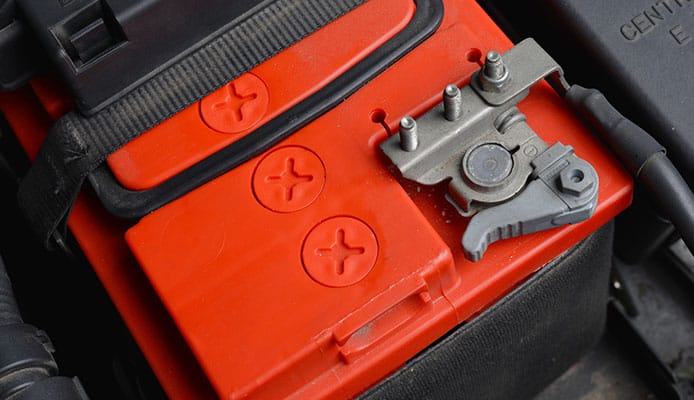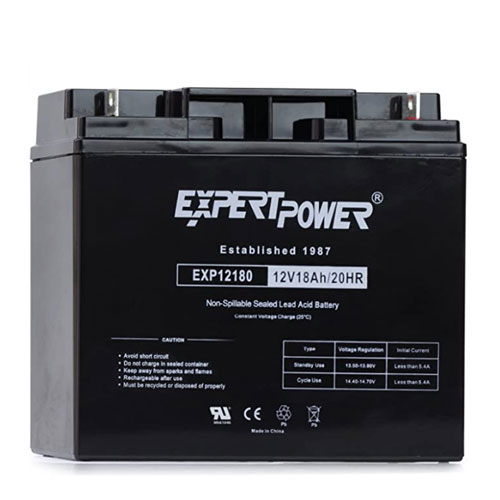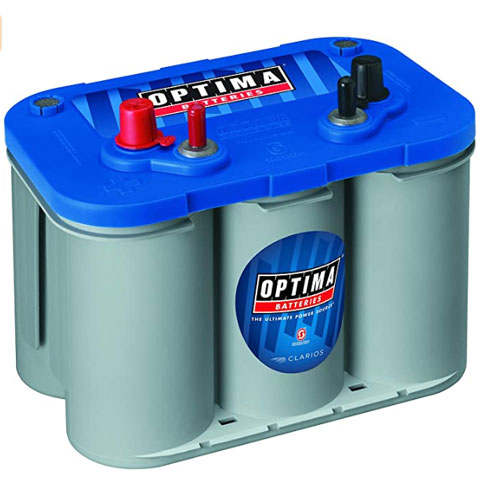-
1.
-
2.
-
3.
-
4.
-
5.
From starting the motor to powering your on-board devices, a marine battery is an inseparable part of your boating equipment. This article will help you find the best marine battery for your vessel, so you won’t ever have to worry about losing power while on the water.
Whether you need a starting, deep cycle, or a dual-purpose battery, our carefully-crafted marine battery reviews will point you in the right direction. And, if you wish to learn about what makes a top rated boat battery, be sure to also check the buying guide below.
OUR TOP PICK
Universal Power Group UB121000 Deep Cycle AGM Marine Battery
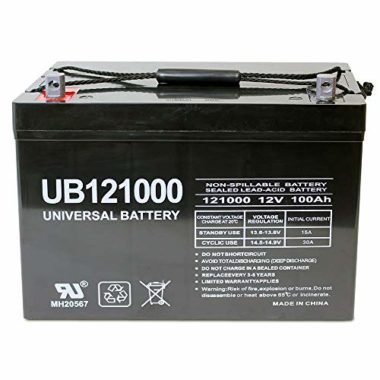
- What Makes This Marine Battery Stand Out
- Fantastic battery capacity (100Ah)
- Spill-proof Sealed Lead Acid construction
- AGM technology makes it maintenance-free
- Excellent shock and vibration resistance
- Covered by a 1-year warranty
Capacity: 100Ah
Voltage: 12V
Type: AGM
Use: Deep Cycle
Dimensions: 12.17 x 6.61 x 9.16 inches
Weight: 63.93 pounds
EDITORS CHOICE
ExpertPower EXP12200 12V Deep Cycle Marine Battery
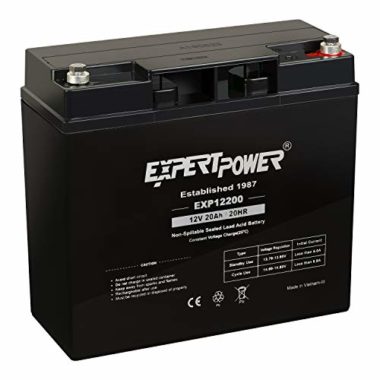
- What Makes This Marine Battery Stand Out
- Rugged ABS construction ensures durability
- Very reliable and maintenance-free
- Compact size saves on-board space
- Very easy and straightforward installation
- Wide temperature range (-40 °F to +140 °F)
Capacity: 20Ah
Voltage: 12V
Type: AGM
Use: Deep Cycle
CCA: 200 Amp
Dimensions: 7.13 x 3.03 x 6.57 inches
Weight: 12.5 pounds
BEST VALUE
ExpertPower EXP12180 Rechargeable Marine Battery
- What Makes This Marine Battery Stand Out
- Secure battery terminal (bolt and nut)
- Durable and tough ABS plastic construction
- Impact-resistant and non-conductive shell
- Compact size for easy installation
- Excellent balance between price and performance
Capacity: 18Ah
Voltage: 12V
Type: AGM
Use: Deep Cycle
CCA: 247 Amp
Dimensions: 7.12 x 3.03 x 6.3 inches
Weight: 12 pounds
Optima Batteries Red Top 35 Starting Marine Battery
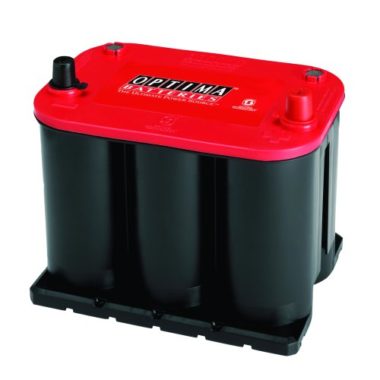
- What Makes This Marine Battery Stand Out
- Great for starting even larger motors
- Produces up to 720 cold cranking amps
- Up to 90 minutes of reserve capacity
- Starts in any weather (cold or hot)
- Polypropylene case provides top-level strength
Capacity: 44Ah
Voltage: 12V
Type: AGM
Use: Starting batteries
CCA: 720 Amp
Dimensions: 9.38 x 7.69 x 6.75 inches
Weight: 31.7 pounds
Optima Batteries Blue Top D34M Starting Deep Cycle Marine Battery
- What Makes This Marine Battery Stand Out
- Excellent for starting and deep cycle use
- Produces 750 cold cranking amps
- Reserve capacity of 120 minutes
- Always starts, even in bad weather
- Mounts and works in any position
Capacity: 55Ah
Voltage: 12V
Type: AGM
Use: Dual Purpose (Starting and Deep Cycle Battery)
CCA: 750 Amp
Dimensions: 10 x 6.88 x 7.94 inches
Weight: 43.5 pounds
VMAX V35-857 AGM Deep Cycle Marine Battery
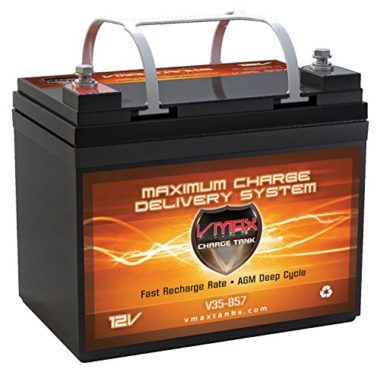
- What Makes This Marine Battery Stand Out
- Ideal for smaller boats and trolling motor use
- Heavy-duty lead alloy improves the lifespan
- Maintenance-free (doesn’t require any servicing)
- Up to 9 hours of runtime with 50% DOD
- Fast recharge time for increased convenience
Capacity: 35Ah
Voltage: 12V
Type: AGM
Use: Deep Cycle
CCA: 300 Amp
Dimensions: 7.7 x 5 x 6.1 inches
Weight: 25 pounds
Optima Batteries Blue Top D31M Starting Deep Cycle Marine Battery
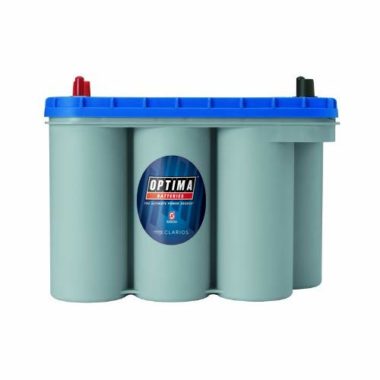
- What Makes This Marine Battery Stand Out
- Great for starting and powering electronics
- Excellent reserve capacity (155 minutes)
- Dual stainless steel battery stud posts
- Shock and damage-resistant polypropylene casing
- Reliable operation regardless of the weather
Capacity: 75Ah
Voltage: 12V
Type: AGM
Use: Dual Purpose
CCA: 900 Amp
Dimensions: 6.56 x 12.81 x 9.38 inches
Weight: 59.8 pounds
Universal Power Group D5722 Sealed Lead Acid Marine Battery
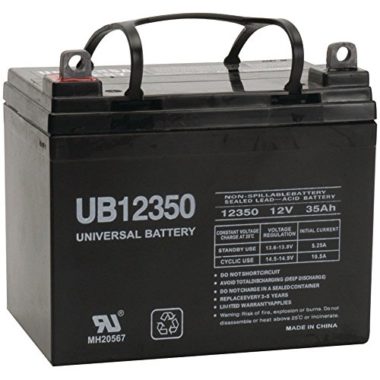
- What Makes This Marine Battery Stand Out
- Lighter than other similarly-sized batteries
- Great for electronic devices, trolling motors, and lights
- Compact design for improved portability
- Great capacity for its size (35Ah)
- Quick and easy battery installation
Capacity: 35Ah
Voltage: 12V
Type: AGM
Use: Deep Cycle
Dimensions: 7.75 x 5.19 x 7.13 inches inches
Weight: 22.5 pounds
Optima Batteries Yellow Top D35 Dual Purpose Marine Battery
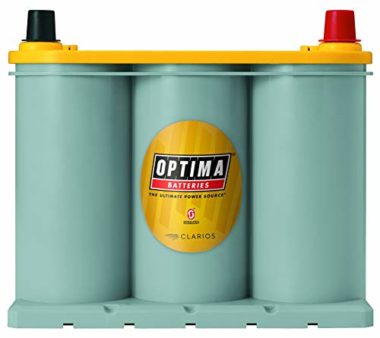
- What Makes This Marine Battery Stand Out
- Ultimate dual purpose batteries
- Produces 620 cold cranking amps
- Reserve capacity of 98 minutes
- Capable of up to 300 discharge cycles
- Steady performance in all weather conditions
Capacity: 48Ah
Voltage: 12V
Type: AGM (Absorbent Glass Mat)
Use: Dual Purpose
CCA: 620 Amp
Dimensions: 6.75 x 9.38 x 7.69 inches
Weight: 36.4 pounds
Optima Batteries Blue Top 34M Marine Battery
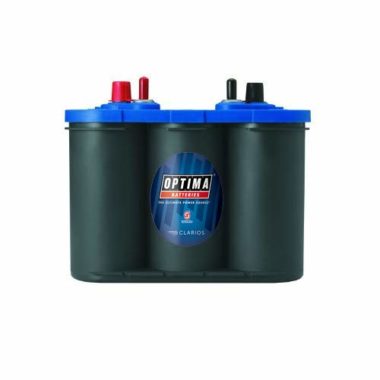
- What Makes This Marine Battery Stand Out
- Exceptional cranking power (800 CCA)
- Steady 100-minute RC for improved performance
- Works well in any mounting position
- Tough damage-resistant polypropylene casing
- Three times more life cycles than similar marine batteries
Capacity: 50Ah
Voltage: 12V
Type: AGM (Absorbent Glass Mat)
Use: Starting batteries
CCA: 800 Amp
Dimensions: 6.88 x 10.06 x 7.94 inches
Weight: 38.4 pounds
How To Choose A Marine Battery – Buying Guide
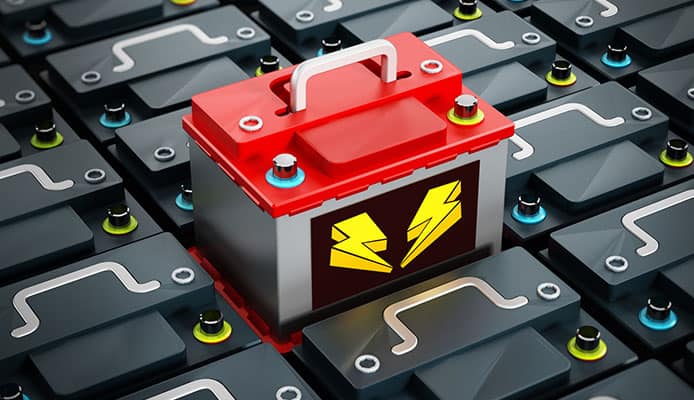
Use (Starting or Deep Cycle)
Depending on what you need the battery for, there are three options that you can get – a starting battery, a deep cycle battery, and a dual-purpose battery.
Starting Batteries: As its name suggests, this battery is used for starting the motor. It generates a lot of power quickly, but using it as a power source for electronics won’t be reliable, and the constant discharge might even damage it.
Deep Cycle Batteries: These batteries are designed to provide a reliable and steady power source over longer periods – fantastic for powering equipment on your boat. However, they usually can’t be used for starting because they can’t generate a burst of amps like a starting battery.
Dual Purpose Batteries: If you don’t have on-board space for two different batteries, a dual-purpose model will get the job done. It can both start the engine and power electronics, but the performance often isn’t as good compared to dedicated starting and deep cycle models (unless you pay a lot of money).
Cold Cranking Amperage
If you plan to use your battery for starting the motor, Cold Cranking Amperage (CCA) measures the starting power that a battery has. The number represents amps that a battery can produce over 30 seconds at 0°F while maintaining a voltage of at least 7.2V. In most cases, anything with a rating of over 700 CCA should easily be able to start a motor on mid-sized boats.
Battery Capacity
This is one of the most important factors when choosing any battery, not just for marine purposes. It’s measured in ampere-hours (Ah) and shows you the amount of power that you can get from your battery.
For example, if a battery has a 20Ah rating, it means that it has a max output of 20 amperes in an hour, or 1 ampere in 20 hours. This parameter is more important for deep cycle batteries, especially if you have a lot of electronics. Of course, keep in mind that you won’t be draining the battery completely and that most batteries have a depth of discharge between 40 and 50%.
While a higher-capacity battery makes use more comfortable, it also means that the unit is larger and heavier. If you need more power, it may be a better idea to connect several units than to buy the largest one.
Reserve Capacity
In addition to amp-hours, reserve capacity (RC) is another important factor when considering how powerful a battery is. It’s measured in minutes and shows you how long a fully charged battery can provide 25 amps at 10.5 volts, until the voltage drops. Logically, a higher number means more power.
Vibration Resistance And Durability
Due to their contents inside, batteries can be sensitive to shocks and vibrations. This can lead to the battery not charging, short-circuiting, or even spilling. Luckily, many of these problems are solved with sealed batteries, which are the best option for a boat.
Besides being sealed, it’s also important that the battery can be mounted in any position (this gives you flexibility and saves space). Lastly, the casing should be made of tough plastic that will tolerate bumps and weather conditions.
Reliability in Marine Conditions
If you’re out on the sea and your marine deep cycle battery fails, you could be left without power for your equipment. Even worse, if the starting battery fails, you won’t have a way of starting the engine.
For this reason, it’s very important to buy a battery that is made specifically for the marine environment. The key features to look out for are that the battery is sealed and that it’s resistant to shocks and heat. We kept this in mind when making our list, and every battery we picked will work great on your boat.
Size and Weight Factor
Many boats have limited space on-board, so battery size might be something worth considering. If you have a dedicated battery slot, always make sure that the model you’re buying can fit and be in the right position.
As for the weight, a heavy battery can be a problem if you have to get it on and off the boat often. Like we’ve mentioned earlier, higher-capacity batteries are both larger and heavier, so you’ll have to find a balance.
Battery Maintenance
Thanks to the advancements in technology, modern SLA batteries require almost no maintenance. Still, paying attention to how you’re using it is very important for its longevity.
Experts advise keeping the battery charged as much as possible – full discharge is its biggest enemy. In addition, try to keep the battery at a steady temperature with no fluctuations, and read the instruction manual for any tips related to your specific model.
Types of Batteries
From a chemical standpoint, three types of batteries are used for marine purposes – AGM, gel, and flooded batteries. Out of the three, AGM batteries are probably the best marine batteries because of their reliability and low maintenance.
Absorbent Glass Mat (AGM) battery: AGM is a type of Sealed Lead Acid (SLA) battery. As its name suggests, it uses fine absorbent glass mats to absorb electrolytes, making the battery spill-proof. They are low-maintenance, shock-resistant, and work great for deep cycle use.
Gel battery: Like the AGM, gel batteries also fall into the SLA category. However, unlike the previous type, they use special silica gel to hold electrolytes (instead of glass mats). They are very stable, work in any position, and are completely resistant to vibrations.
Flooded (wet cell) battery: The cheapest option of the lot, but it’s also the least reliable. This type of battery needs to be held upright to prevent spills, and shocks can potentially ruin it. Still, it’s a good option if you’re budget is limited and you need cheap marine batteries.
FAQs
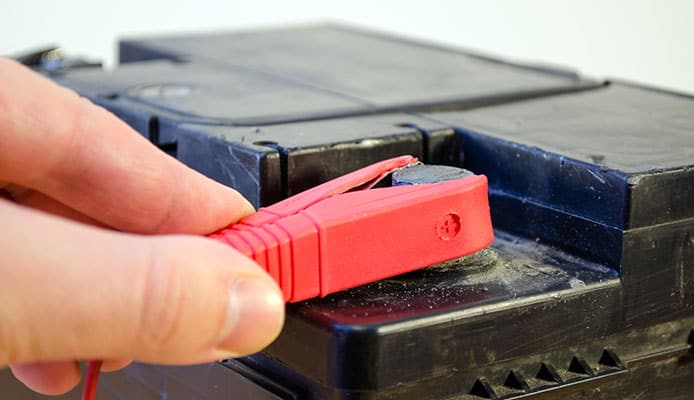
Q: How Long Does A Marine Battery Last?
Depending on the model you get and how you use it, a boat battery lasts from 2 to 5 years. In relation to this, most batteries come with 1 to 3 years of warranty. If you want it to last as long as possible, protect the battery from shocks, extreme temperatures, and full discharging.
Q: What Is Battery Cycle Count?
A battery cycle count refers to the number of times the battery can be fully charged and discharged before it stops working. While this number is often hidden, some types of batteries (AGM for example) have a higher cycle number, making them a good option in terms of durability.
Q: What Is A Deep Cycle Marine Battery?
A deep cycle battery is a battery made to produce a steady power output over a long period of time. Additionally, many of these batteries have a significantly larger depth of discharge too (up to 80%).
Q: How To Test A Marine Battery?
Load testing the battery is fairly easy to do on your own with a digital voltmeter. Before you begin, make sure the battery is fully charged.
Put the prongs of the voltmeter to the proper terminals on the battery, and try starting the boat. A good 12-volt battery can hold a voltage between 9.5 and 10.5 volts for at least 30 seconds. If the voltage starts to drop quickly and significantly, you have a problem with your battery.
Q: How To Charge A Deep Cycle Marine Battery?
For charging your deep cycle marine batteries without removing them, you’re going to need an on-board battery charger. All you need to do is connect the charger clips to the battery terminals (make sure not to mix pluses and minuses). Some chargers even offer various charging speeds, which is great for more sensitive batteries.
Q: Can You Overcharge A Marine Battery?
Yes you can, if you use a cheap battery charger. If the charger has no limit, it can overcharge the electrolyte and damage the battery. For this reason, investing in a multi-stage charger might be a good idea.
Q: What Size Marine Starting Battery Do I Need?
This depends on the size of the motor you have on your boat. Luckily, most motors have this kind of information on them. Like we’ve mentioned, a 700 CCA battery will easily start most smaller and mid-sized motors.
Q: What Is A Dual Purpose Marine Battery?
A dual purpose battery is a model that can be used for both starting the motor and for deep cycles. It’s very convenient to have, especially if you don’t have the space to bring two different batteries.
Q: Can You Use A Deep-Cycle Battery For Starting?
It depends on both the battery and the engine. Most deep cycle marine batteries don’t have a very high crank amperage but, if the battery is powerful enough for the motor, starting with a deep cycle battery is possible.
Globo Surf Overview
Having one of the best marine batteries is an integral part of any boat. Not only do you need marine batteries to start the engine, but they are also required to power all the electronics and appliances you have on-board. Hopefully, our reviews and buying guide have helped you find the perfect battery for your vessel, so you can go on the water without the fear of running out of power.



